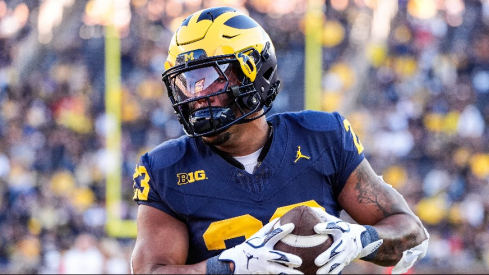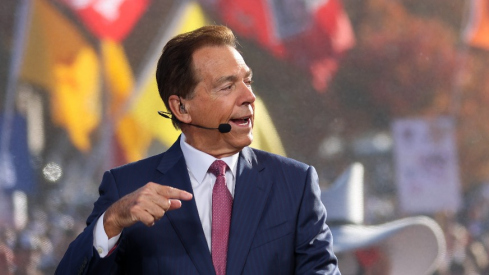The indoor practice field of the Woody Hayes Athletic Center felt like the interior of a refrigerator.
Not cold, but chilled. Some media wore long sleeves, others sported coats. Ryan Day sat down before the contingent of reporters to field the first question. The first words popped out of his mouth and snapped the crisp November air.
“We’ve got to do what it takes to win the game.”
That’s how Day responded when asked if he felt winning the rushing battle was necessary to win The Game. His inflection was the lowercase version, the game. But he was talking about The Game.
“We've got to do what it takes to win the game,” Day said. “Everyone's got to do their job. That's the most important thing. Coaches and players, that's the bottom line.”
Winning the rushing battle helps win a football game – it certainly does in The Game, where the team with more rushing yards has won 23 straight times – but the No. 1 goal is the win itself. Whatever it takes to win The Game in Ann Arbor, Michigan on Saturday, that’s what Day wants to do.
“Now, what does (winning) take? It takes a lot of things,” Day continued. “We can list all the things, but you probably heard me say those, what it takes to win these games over and over again, so I'm a broken record. But if we win the turnover battle, our chances increase of winning the game. If we win the X plays, you start going through all the different things. There's a lot that goes into it. But at the end of the day, our No. 1 goal is to win the game.”
It’s an evolution from the mindset of Day’s program entering the Michigan game in 2024. At least, from an outside view.
Ohio State lost to Michigan for the fourth consecutive year in 2024 by a 13-10 scoreline. The Buckeyes found little success running up the middle against two first-round 2025 NFL draft picks at defensive tackle, Mason Graham and Kenneth Grant. Following the loss, there was a famous meeting between Day and his players.
As recounted in the book Buckeye Brotherhood by Bill Rabinowitz, then-Ohio State, now-Virginia senior defensive end Mitchell Melton spoke up first.
“I raised my hand and asked coach Day, ‘These past two years losing the way we had, what did you learn?’” Melton told Rabinowitz.
He said Day began his answer by talking about scheme. That didn’t satisfy Melton. He said Day talked before the game about the need to establish a run game because the winner of the OSU-Michigan game tends to be whichever has more rushing yardage. But that can be an effect rather than cause. Teams run more when they’re ahead. Melton, and probably others, believed that coaches knew Michigan was a ground-based offense and stubbornly wanted to beat the Wolverines at their own game.
“I realized soon after the game that was very prideful in our own right, and it cost us a Big Ten championship,” Melton said. “What I wanted out of that meeting was to be very honest with ourselves and clear on what happened and why it happened, so that it would never happen again.”
The airing of that hard truth and others sparked Ohio State’s four-game College Football Playoff National Championship run, the greatest run to a championship in college football history, many would say.
Day’s evolution as a coach during his current 15-game winning streak is exactly what he articulated above. He’s focused on doing whatever it takes to achieve victory, whatever that victory looks like. In the CFP, that often meant letting quarterback Will Howard torch the skies with the nation’s best wide receiving corps before handing the ball off to TreVeyon Henderson and Quinshon Judkins for explosive plays against the loosened defense.
Against Texas and at Washington, as the Buckeyes were breaking in new quarterback Julian Sayin, Ohio State played ball control, relying on dominant defensive performances to fuel low-scoring wins. Weaker secondaries like Wisconsin’s received pass-heavy game plans. UCLA has the second-worst run defense in the Big Ten, and Rutgers has the worst in the country. That meant lots of running the ball while star wide receivers Jeremiah Smith and Carnell Tate nursed injuries.
The matchups look a lot different in Ann Arbor. Smith and Tate are trending toward playing. Although it will be cold, winds in Michigan are forecasted at a reasonable five to 10 miles per hour. Ohio State has three of what are probably the five best offensive players in college football with Sayin, Smith and Tate if the latter two do indeed take the field.
Airing out the rock might be the way to go. For all its successes running the ball against the maligned fronts of the Bruins and Scarlet Knights, Ohio State still ranks just 33rd nationally in yards per carry at 4.95. A good number, a massive improvement from where things stood after a 2.9-yard-per-carry day at Illinois and a 3.5-yard-per-carry day at Wisconsin heading into the Buckeyes’ second bye week. But the Michigan run defense is a different beast.
“We’ve got to do what it takes to win the game.”– Ryan Day on whether it's necessary to win the rushing battle to beat Michigan
The Wolverines are No. 10 nationally in yards per carry allowed at 2.98. It’s the best run defense Ohio State’s offense has seen so far this year, at least outside the Buckeye defense it faces daily in practice. Left tackle Austin Siereveld believes the gains his team has made on the ground are real, however.
“We know what the deal is, and we gotta be able to run the ball in these types of games. And we've been practicing for this,” Siereveld said.
Finding success on the ground is important and beneficial for an offense. It might even become necessary if there's a lead to protect or the weather does suddenly get particularly bad. But if Ohio State needs to lean on the pass early to space out Michigan’s defense, then it seems Day is willing to go there.
If that’s what it takes to win The Game and complete his evolution from one year ago.


